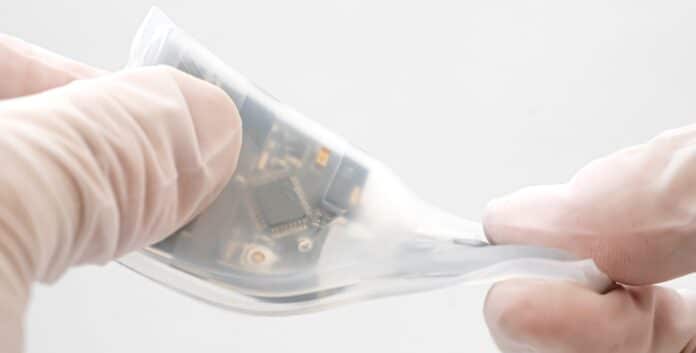Recent advances in wearable ultrasound technologies have demonstrated the potential for hands-free data acquisition. However, there are technical barriers as these probes require wire connections, can lose track of moving targets, and create data-interpretation challenges.
A new study by a team of engineers at the University of California San Diego has reported a fully integrated autonomous wearable ultrasonic-system-on-patch (USoP). It is the first fully integrated wearable ultrasound system for deep-tissue monitoring, including for subjects on the go.
Muyang Lin, a Ph.D. candidate in the Department of Nanoengineering at UC San Diego and the study’s first author, said, “This project gives a complete solution to wearable ultrasound technology—not only the wearable sensor but also the control electronics are made in wearable form factors. We made a wearable device that can wirelessly sense deep tissue vital signs.”
USoP is built on the lab’s previous soft ultrasonic sensor design work. Although, previous soft ultrasonic sensors requires tethering cables for data and power transmission, constraining the user’s mobility.
This technique uses an ultrasound transducer array to interface with a small, flexible control circuit to gather and transmit data wirelessly. The data are interpreted with machine learning, which also tracks moving subjects.
According to the lab’s findings, the ultrasonic system-on-patch allows continuous tracking of physiological signals from tissues as deep as 164 mm, continuously measuring central blood pressure, heart rate, cardiac output, and other physiological signals for up to twelve hours.
“This technology has lots of potential to save and improve lives,” Lin said. “The sensor can evaluate cardiovascular function in motion. Abnormal blood pressure values and cardiac output, at rest or during exercise, are hallmarks of heart failure. For healthy populations, our device can measure cardiovascular responses to exercise in real-time and thus provide insights into the actual workout intensity exerted by each person, which can guide the formulation of personalized training plans.”
Ziyang Zhang, a master’s student in the Department of Computer Science and Engineering at UC San Diego and co-first author, said, “We eventually made the machine learning model generalization work by applying an advanced adaptation algorithm. This algorithm can automatically minimize the domain distribution discrepancies between different subjects, which means the machine intelligence can be transferred from subject to subject. With minimal retraining, we can train the algorithm on one subject and apply it to many other new subjects.”
Journal Reference:
- Lin, M., Zhang, Z., Gao, X., et al. A fully integrated wearable ultrasound system to monitor deep tissues in moving subjects. Nat Biotechnol (2023). DOI: 10.1038/s41587-023-01800-0
